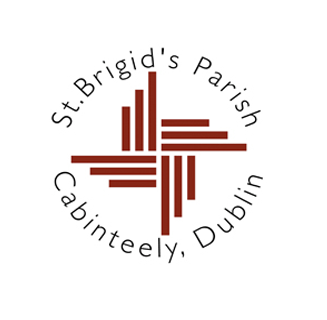Cabinteely was a place name which first came into use in the second half of the seventeenth century and which probably evolved from the name of a popular tavern or pub which was known as Caban tSile or Sheila’s Cabin. On the 10th October 1836, Archbishop Murray opened the present church in Cabinteely Village. This church (which replaced the old eighteenth century chapel) – dedicated to Saint Brigid – reflected the historical context in which it was constructed i.e. a church struggling to re-assert itself soon after Catholic Emancipation in 1829 following centuries of suppression. At this time Cabinteely was part of Kingstown (modern day Dun Laoghaire) Parish. On a number of occasions in the second half of the nineteenth century Cabinteely was affiliated to different parishes e.g. in 1870 Cardinal Cullen placed Cabinteely under the jurisdiction of Ballybrack. In 1917 a Father Ryan of Booterstown was appointed Parish Priest. He chose, however, to live in Foxrock where he built a temporary tin church for local residents. Subsequently in 1934, he built the present Foxrock Church. He was made Canon and continued to live in Foxrock, leaving a curate in the parochial house in Cabinteely. The parish was then known as Cabinteely/Foxrock. In 1971 Foxrock was designated a parish in its own right independent of Cabinteely. Three years later a new parish was established in Johnstown/Killiney.
Saint Brigid of Kildare (Brigit, Bridget, Bridgit, or Bride) (Naomh Bhríghde in Irish; fl. 451- 525) is said to have been born at Faughart near Dundalk, County Louth, Ireland. According to her hagiography, her parents were Dubhthach, pagan king of Leinster, and Brocca, a Christian Pictish slave who had been baptized by Saint Patrick.
Brigid bore the name of one of the most powerful goddesses of the pagan religion that Dubhthach practised. Brigid was the goddess of fire, whose manifestations were song, craftsmanship, and poetry, which the Irish considered the flame of knowledge. In 468, she converted to Christianity, having been inspired by the preaching of St. Patrick, and she followed St. Mel of Armagh to Meath.
Life stories:
Because of the legendary quality of the earliest accounts of Saint Brigid, there is debate among many scholars and even faithful Christians as to the literal historicity of her life. Some insist that Brigid the goddess was made a saint simply to convert Celtic pagans to Christianity, although most historians say that she was a real person whose life was embellished by imaginative hagiographers. Others point to the relic of her head, which Portuguese pilgrims took from her shrine at Downpatrick and brought back to their homeland some time in the 15th Century; the relic now resides in a chapel consecrated to its veneration at Lumier.
A later vita states that upon reaching maturity, she vexed her father by being overly generous to the poor and needy with his milk, butter, and flour. Finally, she gave away his jewel-encrusted sword to a leper. At this point, it was decided that her disposition was best suited for a nun and she was sent to a convent. The legend does not preserve when or how her hitherto pagan father became amenable to such acts. Other tales likewise exist, and the only agreement between the various stories is that a girl was born to an Irish king named Dubhtach and that her name was Brigid.
Around 470 Brigid founded a Christian double monastery, of nuns and monks, at Kildare (Cill-Dara). Either she converted the pagan sanctuary of Cill Dara or built on unused ground nearby, depending upon the particular story consulted. She founded the scriptorium at the monastery where the famous illuminated manuscript the Book of Kildare was created. She died at Kildare on February 1 and is buried at Downpatrick with St. Columcille and St. Patrick, with whom she is co-patron of Ireland.
Legend:
Similar to the association between St. Patrick and the shamrock, a tiny cross made of rushes was linked with St. Brigid. Legend has it she made the cross from rushes she found on the ground beside a dying man in order to convert him. Some houses in Ireland have a Brigid’s Cross, it is a commonly believed by some that a Brigid’s Cross protects the house from fire. A new cross is made each St Brigid’s Day, February 1, and the old one is then burned to keep the fire from the house.
Legend has it that, when she was consecrated to the rank of Abbess, St. Mel was elderly and inadvertently read the consecration for a Bishop and that this could not be rescinded, under any circumstances. While the ordination would have been considered illegitimate, it would still be considered valid (in the technical sense of the terms used by the Roman Catholic Church). What is more likely is that a unique administrative status was conferred upon the Abbess of Kildare, since, while there is no record of St. Brigid acting in the liturgical capacity of a bishop, she and her successor Abbesses at Kildare had administrative authority equal to that of a Bishop until the Synod of Kells in 1152.
St. Brigid’s feast day is February 1.
